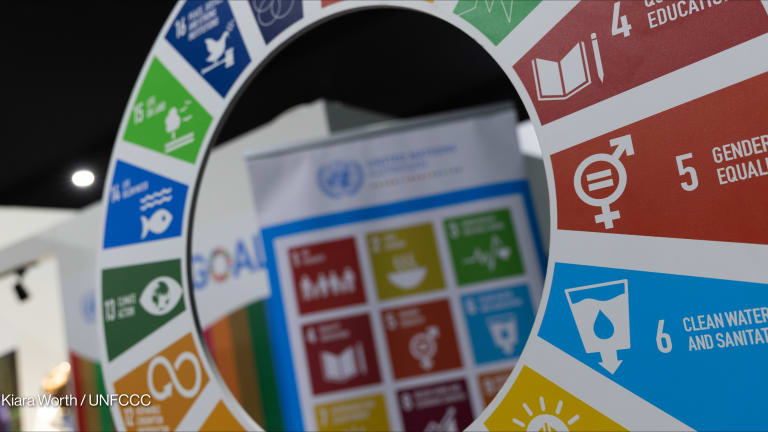
This article usually requires a Devex Pro subscription to read, but we made it free for you so you can get a taste of the exclusive insights and deeper analysis we provide our subscribers. Get unlimited access to Devex Pro by becoming a subscriber. You’ll be supporting a team of global journalists reporting on the forces shaping global development to help you get ahead of the news, trends, and conversations. Try Devex Pro for 15 days for free.
You can read more on this topic in these articles:
► 5 things that set tech donors apart from other philanthropists
► How to choose the right IT for your development organization
► 'Digital strategy is no longer optional': How nonprofits are using the cloud
The intergovernmental process that led to the adoption of the Sustainable Development Goals in 2015 was informed by the largest crowdsourcing of development priorities in history.
“A Million Voices: The World We Want,” a report by the United Nations Development Group, gathered input from 1 million people based on national consultations, surveys, and thematic dialogues.
By contrast, the Millennium Development Goals, which preceded the SDGs, were not developed with wide collective input.
Why local expertise is key to PATH's new strategy
“A lot of what we have included in the strategy is essentially how PATH has worked in the past but we are aiming to do this much better,” Nanthalile Mugala, chief of the Africa region at PATH, tells Devex.
“Sustainable development is the kind of problem you’re only going to solve from the bottom up and collectively,” said Gina Lucarelli, team leader for the U.N. Development Programme’s Accelerator Lab Network, which sources innovations from the grassroots level across 115 countries, and formerly worked as the U.N.’s crowdsourcing for sustainable development adviser.
“Achieving sustainable development is a distributed problem. It rests in the hands and minds and actions of 8 billion people. And you can imagine the trillions of decisions that day that impact that,” she said.
There’s a name for that kind of crowdsourcing: collective intelligence, which refers to drawing on the knowledge of large numbers of people to address societal challenges. UNDP sees collective intelligence as essential to achieving the SDGs.
Its recent report, “Collective Intelligence for Sustainable Development: Getting Smarter Together,” explores the value of collective intelligence through six use cases: involving marginalized individuals and communities; navigating complex systems; anticipating, monitoring, and responding to risk; distributed problem solving; real-time environmental monitoring; and new forms of accountability and governance.
The study examines the practice of “pooling collective brain power to create a better balance among equity, environmental protection and economic prosperity.”
UNDP is among the groups calling on the global development community to consider how technology can accelerate participatory methods, such as crowdsourcing, to gather data and ideas with greater speed and scale than ever before.
How technology is powering collective intelligence
Rapid technological growth offers new ways to tap into the intelligence of the 8 billion people on the planet to address societal challenges.
“Collective intelligence is an old idea: How do groups of people work together so they become smarter together?” said Kathy Peach, director of the Centre for Collective Intelligence Design at Nesta, formerly the National Endowment for Science, Technology and the Arts, an innovation foundation based in the United Kingdom. “What’s changed is how digital technologies are enabling that collective intelligence to be mobilized at scale, and machine intelligence is augmenting our intelligence in different ways.”
Collective intelligence combines different sources of intelligence, from large numbers of people to new sources of data ranging from mobile phones to satellites, with emerging digital technologies including artificial intelligence.
What sets the practice apart is not only the commitment to bringing in a diversity of perspectives but also to ensure that information is shared back with communities, making the process collaborative rather than extractive, Peach added.
“Collective intelligence harnesses the power of ‘we’ — not me or them, but us.”
— Gift Ntuli, head of experimentation, UNDP Zimbabwe Accelerator LabNesta has developed a collective intelligence design playbook to help organizations bring diverse sets of people, data, and technology together to address societal challenges. UNDP Accelerator Labs are applying these principles to their work and sharing what they have learned with Nesta so the organization can refine these techniques.
For example, UNDP Zimbabwe Accelerator Lab used collective intelligence methods to tackle issues related to food security in the context of COVID-19.
When COVID-19 hit, the Ministry of Finance and Economic Development in Zimbabwe had a hard time figuring out who should get what kind of support, because there was a lack of data on the highly complex and informal agriculture production and consumption ecosystem, according to Gift Ntuli, head of experimentation at UNDP Zimbabwe Accelerator Lab.
“The whole food ecosystem in Zimbabwe is a black box. There’s the input, the products that farmers produce, and the output is consumption. And what happens in between, no one understands,” he said.
UNDP Zimbabwe worked with a range of partners, including Viamo, which conducts mobile surveys, to hear directly from vendors at local markets. This work yielded critical insights, Ntuli said. For example, it found that COVID-19 had a disproportionate impact on female vendors, who tend to sell mostly perishable products compared with male vendors, who tend to sell products with a longer shelf life.
UNDP Zimbabwe’s work on food security is just one example of how collective intelligence increases the diversity of people who come together to solve a problem.
“Collective intelligence harnesses the power of ‘we’ — not me or them, but us,” Ntuli said.
Mainstreaming the approach
While collective intelligence is a growing field, one of the challenges that stands in the way of scaling the approach more widely is the need for open data and open technology infrastructure that underpins many of these projects, Peach said.
“What we have seen through our work is you get a lot of small-scale collective intelligence projects, but not the connection between them that enables that scale, and not the sharing of intelligence that would enable these small projects to become more than the sum of their parts,” she said.
Peach called on donors to invest in building digital infrastructure that enables more people to tap into the power of collective intelligence.
In the meantime, UNDP is working to build collective intelligence into the default of how it does development, Lucarelli said.
“It’s a new way of doing development that is different from relying on expert advice, fly in and fly out consultants, and traditional forms of planning where you invest a lot in multiyear planning and then the world changes in the meantime and it becomes irrelevant,” she said.
She said she sees the collective intelligence term as “a provocation against artificial intelligence.” There is a false assumption that technology alone can solve complex development challenges, Lucarelli said.
“Yes, technology has a contribution to make, but humans also have an incredible role to play,” she said. “The field of collective intelligence is about understanding: What’s the role for humans, and what’s the role for machines?”








